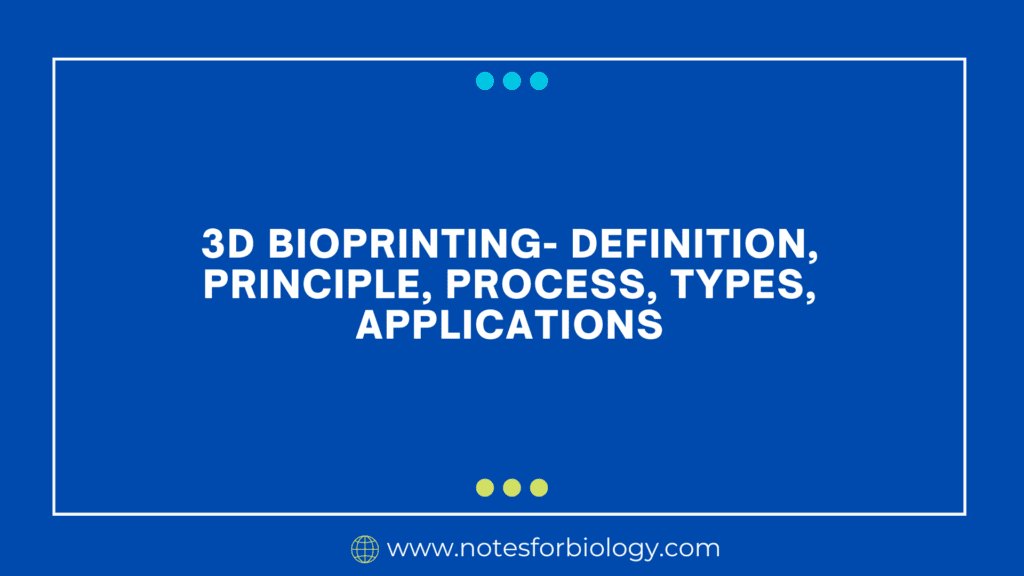3D Bioprinting is using 3D printing processes, bioprinting is a state-of-the-art technology that deposits layers of living cells to produce living tissues and organs. The exciting topic of bioprinting uses cells, growth factors, bio-inks, and biomaterials to produce functional structures utilizing 3D printing and biology.
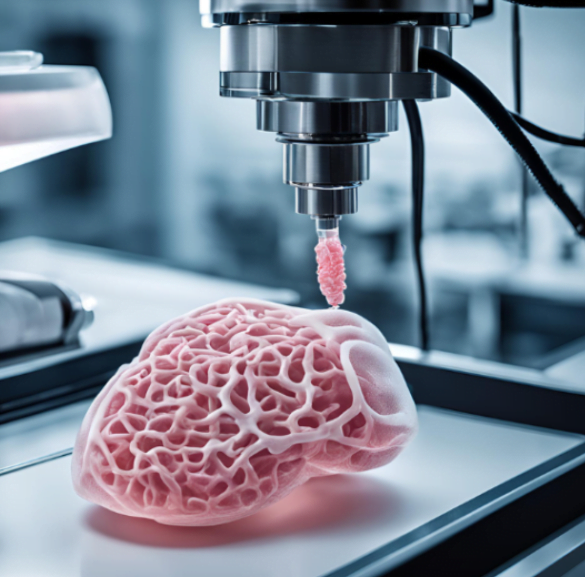
Table of Contents
Principle of 3D Bioprinting
The principle of 3D bioprinting are
Biomimicry
Through bioprinting, biological processes occur naturally. It seeks to imitate the complex architecture of biological things.
Autonomous self-assembly
During printing, cells and bio-inks self-organize to form useful structures.
Mini tissues building blocks
Mini-tissues, which are tiny functional pieces of tissues and organs, are created using this bioprinting technique. The smallest anatomical and functional unit of the organs, such as the kidney neuron, is represented by the tiny tissues.
Process of 3D Bioprinting
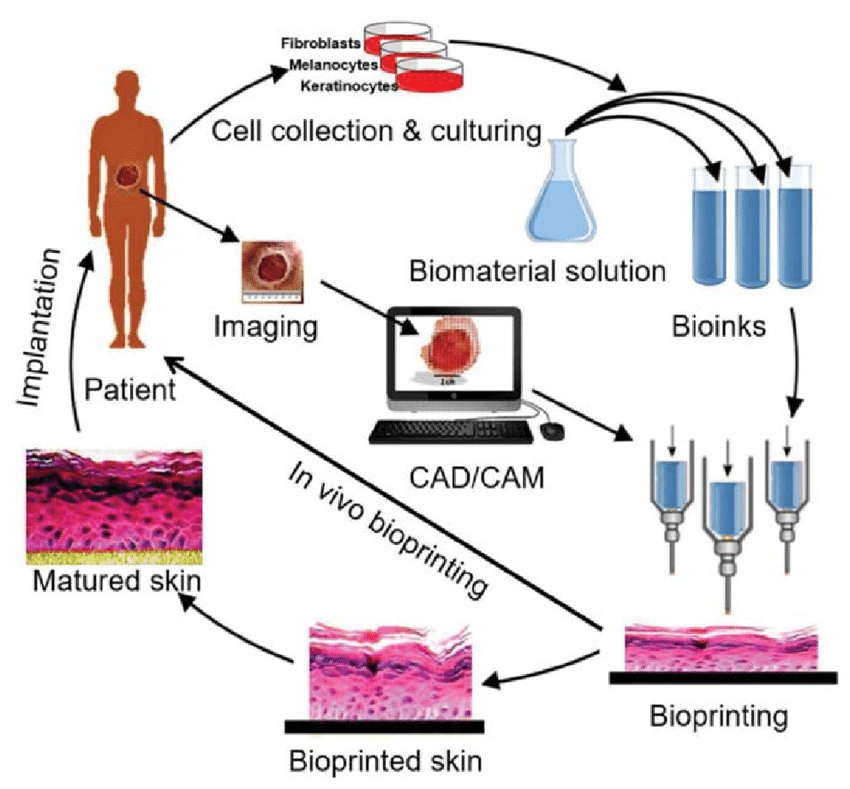
Pre bioprinting
In this step, imaging data—such as CT or MRI scans—is used to create a model. After being separated, cells are multiplied, and combined with a unique substance that gives them nutrition to stay alive.
Bioprinting
The printer builds up the required structure by layering on bio-inks.
Post bioprinting
The final stage of the bioprinting process, known as postbioprinting, is crucial for giving the printed structure solidity.
Chemical and physical stimulations are needed to keep biological matter in its proper structure and functioning.
Types of 3D Bioprinting
The types of 3D Bio printing are mentioned below:
Extrusion based bioprinting
In extrusion-based bioprinting, a robotic system that is automated is used to dispense a biological medium, commonly known as bioink.
A computer-controlled device accurately deposits the bioink during the bioprinting process, which produces an arrangement of cells encased in cylindrical filaments. After that, these filaments are piled to produce 3D structures with certain shapes.Tissue engineering, regenerative medicine, and the creation of organ models for medication testing and disease study are among its uses.
Inkjet based bioprinting
Using customised inkjet printers, picoliter droplets of bioink are precisely deposited onto a hydrogel substrate or culture plate in the process of inkjet-based bioprinting.
Inkjet bioprinting, as opposed to conventional inkjet printing, which prints 2D and 3D structures on paper using ink, substitutes biological material (bioink) for the ink.
Because of the non-contact nature of the technique, bioink may be precisely placed without coming into contact with the substrate.
Pressure-asserted bioprinting
One method utilised in 3D bioprinting is pressure-assisted bioprinting. This is how it operates:
In order to create a 3D biological structure, the PAB process entails extruding biomaterials—such as hydrogels, cells, proteins, and ceramic solutions—through a printer nozzle. The accurate deposition of materials is ensured by the applied pressure.
Its benefits include: Better resemblance to genuine tissues due to the ability to implant mixed cells.Its allows for the precise construction of intricate structures.
Laser-assisted bioprinting
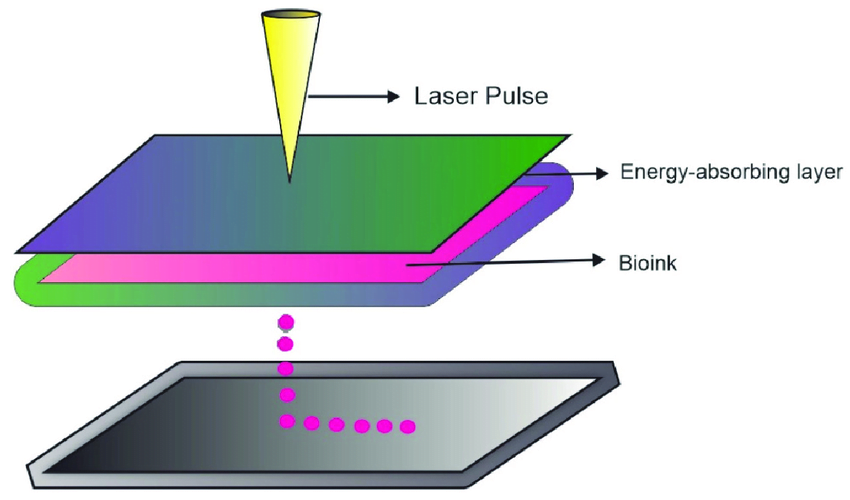
One particular method of bioprinting is called laser-assisted bioprinting (LAB).
It uses controlled laser deposition to apply biological materials to a substrate.
This is how it operates: Energy from a laser is focused on an absorbent layer, commonly a glass plate. This energy propels the biological ink, or bio ink, onto the receptive substrate by means of a high-pressure liquid bubble. As a result, intricate 3D structures are produced by precisely depositing cells or bio inks
Stereolithography
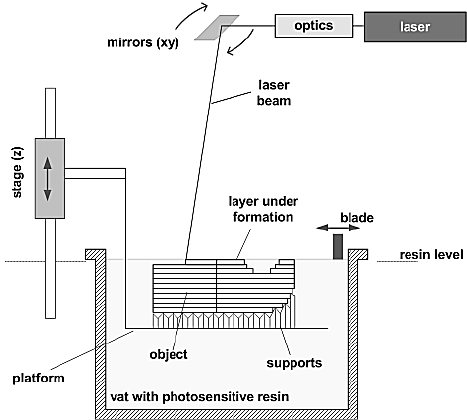
Stereolithography (SLA) is an additive manufacturing technique where liquid resin is cured by a light source into hardened plastic. It is sometimes referred to as vat photopolymerization or resin 3D printing. Let’s investigate this intriguing technology in more detail. In SLA, a vat containing a liquid photopolymerizing resin is selectively illuminated by a laser or digital light projector (DLP). Chemical oligomers and monomers are present in the photopolymer resin.
These oligomers and monomers cross-link to create polymers when exposed to light.
To construct a three-dimensional item, the cured resin is gradually raised layer by layer.
Application of 3D Bioprinting
3D bioprinting is revolutionising several sectors with its wide range of applications. Let’s examine a few of the main sectors where this state-of-the-art technology is having a big influence:
Tissue Engineering and Regenerative Medicine
Organ Printing: Using three-dimensional bioprinting, it is possible to create functional tissues and organs. Researchers are harnessing patient-specific cells to create prosthetic livers, hearts, and kidneys. Patients may be able to get these bioengineered organs in substitution of failing or damaged organs.Skin Grafts: Bioprinted skin grafts can be used to treat burns or other skin ailments and help wounds recover. Bioprinted scaffolds have the potential to aid patients suffering from joint problems or fractures by facilitating the regeneration of bone and cartilage.
Drug Testing and development
Pharmaceutical companies may more accurately test for medication safety and efficacy thanks to bioprinted tissue models, which closely resemble real tissues. This expedites the discovery of new drugs and lessens the necessity for animal testing.Drug interactions with certain tissues can be studied by researchers, opening the door to personalised medical techniques.
Cancer research and drug screening
Researchers can better understand cancer growth, medication resistance, and metastasis with the use of bioprinted tumour models. High-throughput drug screening to find possible anti-cancer drugs is made possible by these models.
Disease Modeling
Creating in vivo or in vitro systems that mimic some features of a disease is known as disease modelling. With the aid of these models, scientists can investigate the causes of various diseases, evaluate possible treatments, and learn more about how diseases develop. Here are some essential details regarding illness modelling.
Customized Implants and Prosthetics:
Implants and prosthetics can be made to order using 3D bioprinting. For joint replacements, cranial reconstructions, and bone abnormalities, surgeons can create implants specifically for each patient. Better results can be achieved by printing biocompatible materials layer by layer to match the anatomy of the patient.
Skin and Wound Healing:
Wound healing is one use for bio printed skin constructions. These structures can be applied to the development of customized therapeutics, cell migration research, and wound dressing testing.
Imagine a day when 3D bioprinting technology allows burn patients to receive skin grafts made entirely of their own cells.
Bio fabrication of Food:
Although it hasn’t directly connected to medical, 3D bioprinting has been investigated for the manufacture of food. Foods derived from plants and cells are being printed by researchers.
Just print it! Here’s an environmentally friendly alternative to rearing animals for meat.
Frequently Asked Questions(FAQ)
Define Bioprinting in short?
Bioprinting is using 3D printing processes, bioprinting is a state-of-the-art technology that deposits layers of living cells to produce living tissues and organs. The exciting topic of bioprinting uses cells, growth factors, bio-inks, and biomaterials to produce functional structures utilising 3D printing and biology.
What is Mini tissues building blocks?
Mini-tissues, which are tiny functional pieces of tissues and organs, are created using this bioprinting technique. The smallest anatomical and functional unit of the organs, such as the kidney neuron, is represented by the tiny tissues.
List the principle of 3D Bioprinting?
The principle of bioprinting are
Biomimicry
Autonomous self-assembly
Mini tissue building blocks
Related articles

